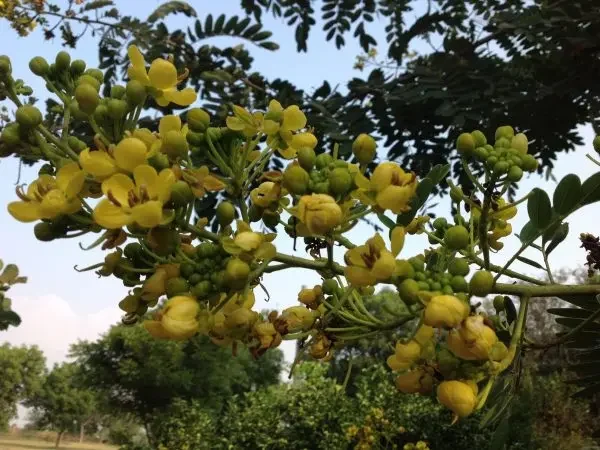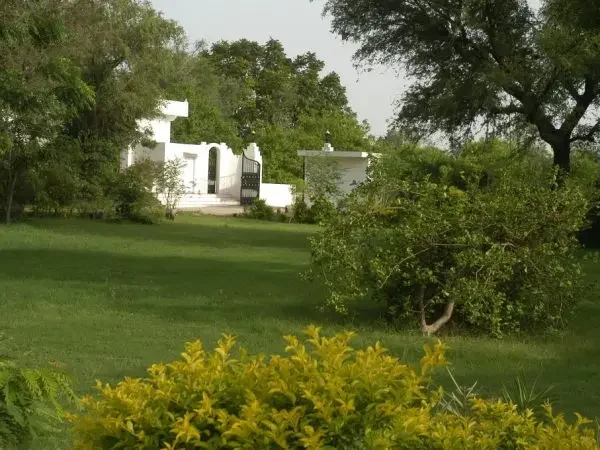
The numerous Siamese Cassia (Senna Siamea) trees on the Savista estate have burst into full bloom with the onset of late autumn and the early signs of winter, one of the best seasons in Rajasthan. And everywhere the golden glow of the flowers is lighting up the gardens, and acting as a powerful magnet for our birds and butterflies who come for the rich nectar.
Seasonal Rhythm of the Cassia
The major flowering season starts at the end of the rains and stops in
December. Since the rains ended late this year, the flowering has reached its peak in just the last few weeks. Hopefully, it will go on for longer. There is another shorter flowering season in May. For the rest of the year, the tree remains heavily clothed in rich green leaves, with the odd flower cluster peeping through but nowhere near as exhuberant as it is now. The fruits ripen in late February.
Characteristics and Landscaping Value
It is a small to medium sized tree, upto 15 to 20 metres tall, with a low branching high crown. The leaves are dark green and shining and the flowers are golden yellow with brown slightly curved pods that grow in dense clusters at the end of the shoot. The tree is an evergreen and provides shade relief in the hot summer months. Being fast growing, shady and decorative, it is a good choice for planting along avenues and roadsides. At Savista, our Siamese Cassia trees stand along with Gulmohurs (which flower in extravagant clusters of red and orange through the summer) and Neem trees (whose fragrant creamy flower clusters appear through the spring) to create a shade belt around the haveli. We have observed, however, that unlike the Gulmohur and Neem, the heavily leaved branches of the Siamese Cassia are unable to take the fury of the Rajasthan monsoon storms, and although the tree itself stands firm, its branches break easily with strong winds.
Native Roots and Regional Significance
The tree is native to south and south east Asia – India, Burma, Sri Lanka, Indonesia , Malaysia and Thailand – although its first home is believed to be Thailand; hence its name. Several places in Thailand are named after it and it is the provincial tree of the Chaiyaphum province.
Its flowers, fruits and leaves are used extensively in Thai, Burmese and Sri Lankan cooking, with the waters draining out from them being removed a few times during the cooking process to get rid of the toxins. The tree is valued across the Asian region for its medicinal properties, particularly as a tranquilising and hypnotic agent.
The wood – greyish in colour – is highly prized for Chinese furniture making.
The tree is also known as Blackwood Cassia, Bombay Blackwood, Thai copper pod, Thailand shower, and Kassod tree (English), Johor, Juwara (south east Asian languages), and Kassod, Seemia, Kesariya shyam (Hindi).
Names and Classification
Botanical name: Senna Siamea
Family: Caesalpiniaceae / Fabaceae (gulmohur family). It is a legume.
Interesting websites on related themes:
www.projectnoah.org – a tool to explore and document wildlife and a platform to harness the power of citizen scientists everywhere;
www.flowersofindia.net – a work-in-progress compendium of flowers of India, including trees, grasses, medicinal plants, flowers in ancient Indian
literature, etc.;
www.08hachi.blogspot.in – Flora Fauna World – about flora, fauna, Latin
names, and images

Conclusion
At Savista, the Siamese Cassia adds a magical golden patch to the gardens in Rajasthan during the winter months, holding the tenuous weight of the season’s muted splendor. More than just a pretty display, the tree signifies the relationships between beauty, ecology, and history–from its role in providing sustenance for butterflies to providing medicinal sedative capabilities to calm the human mind. Whether it represents glory in its capped golden blooms or a tribute to regional and cultural attachment, the Siamese Cassia stands as a proud and poetic reminder of the manifold value in the flowering tree legacy of Jaipur.

